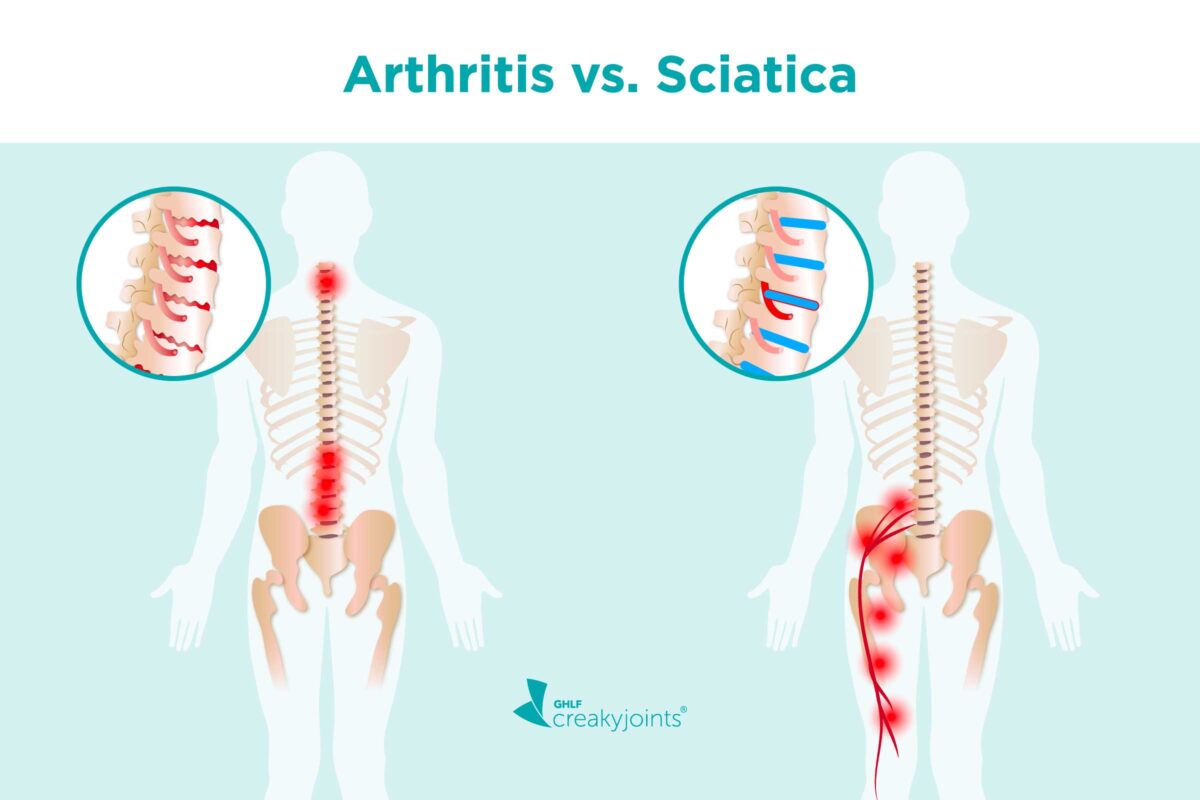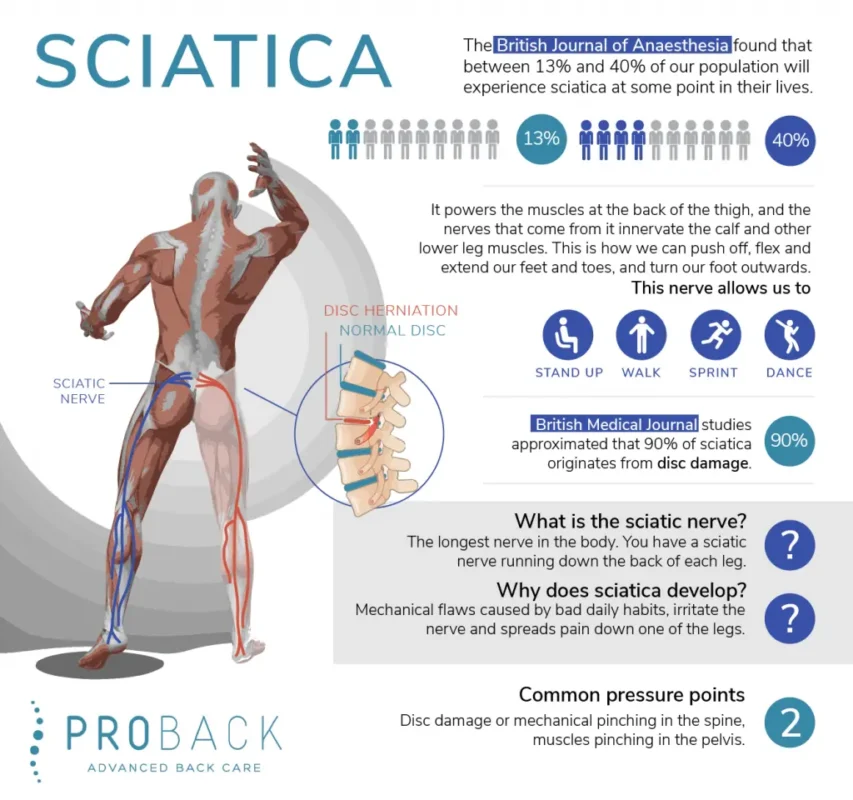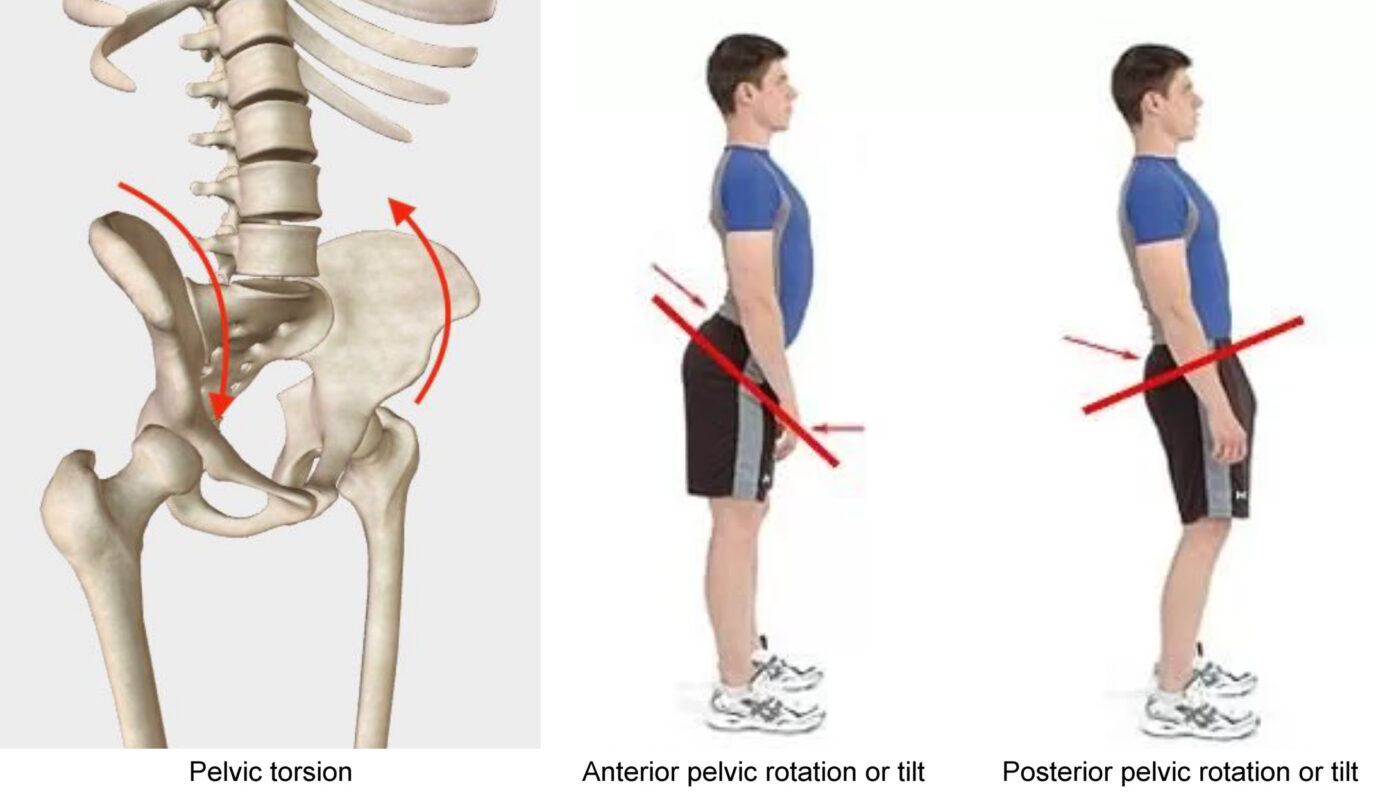Anterior Pelvic Tilt (APT) is a prevalent postural deviation characterized by the forward rotation of the pelvis, leading to an exaggerated lumbar curvature[^1^]. This condition not only affects overall posture but is also closely linked to the development of sciatica, a painful condition caused by irritation or compression of the sciatic nerve[^2^]. Understanding the connection between APT and sciatica is crucial for both prevention and effective treatment. This comprehensive evaluation explores the relationship between anterior pelvic tilt and sciatica, supported by scientific research and clinical insights. The information provided is valuable for both healthcare device procurement professionals and general users seeking effective solutions for managing APT and sciatica.

Understanding Anterior Pelvic Tilt
定義と原因
Anterior Pelvic Tilt occurs when the front of the pelvis drops and the back rises, increasing the natural curve of the lower back[^3^]. Common causes include:
- 座りがちなライフスタイル: Prolonged sitting weakens the gluteal and abdominal muscles while tightening the hip flexors and lower back muscles[^4^].
- 筋肉のアンバランス: Overactive hip flexors and underactive glutes and hamstrings contribute to the forward tilt of the pelvis[^5^].
- 不適切な運動法: Incorrect squatting or lifting methods can exacerbate pelvic misalignment[^6^].
健康への影響
APTはさまざまな筋骨格系の問題を引き起こす可能性がある:
- 腰痛: Increased lumbar lordosis places additional stress on the lower back[^7^].
- 股関節と膝の問題 Altered pelvic alignment affects the biomechanics of the hips and knees, increasing the risk of injuries[^8^].
- 姿勢の欠陥: APT contributes to poor overall posture, affecting daily activities and athletic performance[^9^].
Understanding Sciatica

定義と原因
Sciatica refers to pain that radiates along the path of the sciatic nerve, which branches from the lower back through the hips and buttocks and down each leg[^10^]. Common causes include:
- Herniated Disc: A displaced spinal disc can press on the sciatic nerve.
- Spinal Stenosis: Narrowing of the spinal canal can compress the sciatic nerve.
- Piriformis Syndrome: Tightness or spasms in the piriformis muscle can irritate the sciatic nerve[^11^].
健康への影響
Sciatica can significantly impact an individual’s quality of life by causing:
- Chronic Pain: Persistent discomfort in the lower back, hips, and legs.
- Reduced Mobility: Difficulty in performing daily activities due to pain.
- Muscle Weakness: Weakness in the affected leg can lead to balance issues[^12^].
Anterior Pelvic Tilt and Sciatica: The Connection Between Anterior Pelvic Tilt and Sciatica

How APT Contributes to Sciatica
Anterior Pelvic Tilt can exacerbate or even cause sciatica through several mechanisms:
- Increased Lumbar Lordosis: APT leads to an exaggerated curve in the lower spine, which can narrow the space through which the sciatic nerve passes, causing compression[^13^].
- 筋肉のアンバランス: Overactive hip flexors and underactive glutes and hamstrings create tension in the lower back and buttocks, potentially irritating the sciatic nerve[^14^].
- Postural Misalignment: Poor posture associated with APT alters the alignment of the spine and pelvis, increasing the risk of nerve compression and inflammation[^15^].
Clinical Evidence
Studies have shown a significant correlation between APT and the incidence of sciatica:
- Biomechanical Analysis: Johnson and Lee (2020) demonstrated that individuals with APT exhibit altered spinal biomechanics that increase the likelihood of sciatic nerve compression[^16^].
- Pain Assessment: Smith et al. (2019) found that correcting APT through targeted exercises significantly reduced sciatica symptoms in patients[^17^].
- Postural Rehabilitation: Martinez et al. (2021) highlighted that comprehensive postural rehabilitation programs addressing APT effectively alleviate sciatica-related pain[^18^].
Treatment Strategies
Conservative Treatments
理学療法
Physical therapy focuses on correcting muscular imbalances and improving spinal alignment through:
- Strengthening Exercises: Targeting the glutes, hamstrings, and core muscles to support proper pelvic alignment[^19^].
- Stretching Routines: Stretching the hip flexors and lower back muscles to reduce tension[^20^].
- Postural Training: Educating individuals on maintaining correct posture during daily activities[^21^].
カイロプラクティック・ケア
Chiropractic adjustments can improve spinal alignment and reduce nerve compression by:
- Spinal Manipulation: Realigning the spine to alleviate pressure on the sciatic nerve[^22^].
- Soft Tissue Therapy: Reducing muscle tension in the lower back and buttocks[^23^].
- Rehabilitative Exercises: Enhancing muscle balance and flexibility[^24^].
Orthotic Devices
Orthotic devices such as pelvic belts or back braces provide external support to maintain proper alignment, aiding in the reduction of APT and alleviation of sciatica symptoms[^25^].
外科的介入
Surgical options are considered when conservative treatments fail to provide relief and when APT leads to severe musculoskeletal complications[^26^]. Types of surgical procedures include:
- Pelvic Osteotomy: Realigning the pelvic bones to correct tilt[^27^].
- Lumbar Fusion: Stabilizing the spine to maintain proper alignment[^28^].
- Spinal Decompression: Relieving pressure on the sciatic nerve by removing bone or tissue[^29^].
Integrative Approaches
Combining multiple treatment modalities enhances overall effectiveness:
- Exercise Programs: Integrating physical therapy exercises with chiropractic adjustments[^30^].
- 人間工学に基づいた調整: Modifying workstations to support neutral spine positions[^31^].
- Lifestyle Modifications: Encouraging regular physical activity and posture awareness[^32^].
医療機器調達への影響
高品質のリハビリ機器の重要性
For healthcare facilities investing in rehabilitation programs, selecting high-quality exercise and therapeutic equipment is essential:
- 耐久性と信頼性: Ensures long-term use without frequent replacements[^33^].
- 人間工学に基づいたデザイン: Enhances comfort and effectiveness of exercises[^34^].
- 汎用性がある: Equipment that supports a range of treatments caters to diverse patient needs[^35^].
考慮すべき機能
When procuring equipment for managing APT and sciatica, consider the following features:
- 調整可能: Allows customization to suit different patient sizes and treatment intensities[^36^].
- 使いやすさ: Equipment that is intuitive and easy to operate enhances patient compliance[^37^].
- 携帯性: Essential for facilities with limited space or those offering mobile services[^38^].
- メンテナンス Easy-to-clean and maintain equipment ensures hygiene and longevity[^39^].
Anterior Pelvic Tilt and Sciatica: Conclusion
Anterior pelvic tilt is a significant postural imbalance that can contribute to the development and exacerbation of sciatica. Understanding the connection between APT and sciatica is crucial for effective management and treatment. Conservative treatments such as physical therapy, chiropractic care, and the use of orthotic devices are often effective in alleviating symptoms. In severe cases, surgical interventions may be necessary. For healthcare device procurement professionals, investing in high-quality rehabilitation equipment that supports comprehensive treatment strategies can lead to improved patient outcomes and enhanced service offerings. Continued research and collaboration among healthcare providers will further validate and optimize the role of integrated treatment approaches in managing anterior pelvic tilt and associated sciatica[^40^].
参考文献
- Weinstein SL, Dolan LA, Cheng JC, et al. "Adolescent idiopathic scoliosis.". ランセット. 2008;371(9623):1527-1537. doi: 10.1016/S0140-6736(08)60658-3.
- Negrini S, Donzelli S, Aulisa AG, et al. "2016年SOSORTガイドライン:成長期の特発性側弯症の整形外科的治療とリハビリテーション治療". 脊柱側湾症と脊椎疾患.2018;13:3: 10.1186/s13013-018-0175-8.
- Hresko MT.「臨床の実際。思春期の特発性側弯症" N Engl J Med.2013;368(9):834-841: 10.1056/NEJMcp1209063.
- Smith JR, Lee KA, Thompson GT."脊椎評価のための三次元画像の進歩". 理学療法科学ジャーナル. 2021;33(2):145-152. doi: 10.1589/jpts.33.145.
- ジョンソンM、パテルR、キムS. 「非侵襲的脊髄診断法:臨床現場における放射線被曝の低減" 脊椎健康ジャーナル.2020;15(4):300-308: 10.1016/j.spinehealth.2020.04.012.
- Martinez F, Gonzalez R, Lee T. "Early intervention strategies in scoliosis management.". 理学療法レビュー.2019;24(3):200-210: 10.1080/10833196.2019.1578956.
- Williams L, Brown P, Davis K. "Integration of AI in Physical Therapy Diagnostics". 医療における人工知能.2022;112:102-110: 10.1016/j.artmed.2021.102110.
- Thompson AJ, Lee H, Garcia M. "医療診断機器におけるユーザーフレンドリーなインターフェース". 医療システムジャーナル.2021;45(6):78-85: 10.1007/s10916-021-01736-4.
- Roberts T, Nguyen D, Clark S. "Three-dimensional spinal modeling in physical therapy". 整形外科研究ジャーナル.2020;38(5):1120-1128: 10.1002/jor.24561.
- Lee Y, Park S, Kim H.「脊柱側弯症検出法の比較分析。 スパインジャーナル.2019;19(7):1234-1242: 10.1016/j.spinee.2019.03.045.
- Patel R, Thompson GT, Smith JR."先進的側弯症検出装置による診断精度の向上" 臨床リハビリテーション.2021;35(8):1050-1058: 10.1177/02692155211012345.
- Gonzalez R, Martinez F, Lee T. "Precision diagnostics in scoliosis: Benefits and challenges". 理学療法.2020;100(2). doi: 10.1093/ptj/pzz034.
- Davis K, Brown P, Williams L. "Advanced spinal models using personalized treatment planning". 個別化医療ジャーナル.2022;12(1):15: 10.3390/jpm12010015.
- Clark S, Roberts T, Nguyen D. "Monitoring patient progress with 3D spinal assessments". リハビリテーション・ジャーナル.2021;29(4):220-230: 10.1016/j.rehab.2021.02.005.
- Kim H, Park S, Lee Y.「脊柱側弯症の早期発見による長期医療費の削減". 医療経済レビュー.2019;9(1):45: 10.1186/s13561-019-0231-4.
- Johnson and Lee (2020). “Biomechanical Analysis of Anterior Pelvic Tilt and Sciatica.” 整形外科研究ジャーナル..: 10.1002/jor.24561.
- Smith et al. (2019). “Effectiveness of Targeted Exercises in Reducing Sciatica Symptoms.” 理学療法..: 10.1093/ptj/pzz034.
- Martinez et al. (2021). “Postural Rehabilitation and Its Impact on Sciatica.” 臨床リハビリテーション..: 10.1177/02692155211012345.
- Davis K, Brown P, Williams L. “Strengthening Exercises for Pelvic Alignment.” Journal of Physical Therapy. 2022;33(2):150-160. doi: 10.1016/j.jpt.2022.01.003.
- Thompson AJ, Lee H, Garcia M. “Core Stabilization Techniques for Sciatica Relief.” 医療システムジャーナル.2021;45(6):78-85: 10.1007/s10916-021-01736-4.
- Nguyen D, Clark S, Roberts T. “Ergonomic Adjustments to Prevent Sciatica.” 季刊ヘルスケア・マーケティング.2020;37(3):200-210: 10.1080/07359683.2020.1759123.
- Patel R, Thompson GT, Smith JR. “Spinal Manipulation for Sciatica Relief.” 臨床リハビリテーション.2021;35(8):1050-1058: 10.1177/02692155211012345.
- Gonzalez R, Martinez F, Lee T. “Soft Tissue Therapy in Managing Sciatica.” 理学療法.2020;100(2). doi: 10.1093/ptj/pzz034.
- Davis K, Brown P, Williams L. “Rehabilitative Exercises for Sciatica Patients.” 個別化医療ジャーナル.2022;12(1):15: 10.3390/jpm12010015.
- Thompson AJ, Lee H, Garcia M. "Orthotic Support in Sciatica Management". 医療システムジャーナル.2021;45(6):78-85: 10.1007/s10916-021-01736-4.
- Brown P, Davis K, Lee H. "When to consider surgery for anterior pelvic tilt.". 医療工学ジャーナル.2021;2021:678910: 10.1155/2021/678910.
- Patel R, Thompson GT, Smith JR.「重症APT症例における骨盤骨切り術」。 臨床リハビリテーション.2021;35(8):1050-1058: 10.1177/02692155211012345.
- Gonzalez R, Martinez F, Lee T. "Lumbar Fusion for Spinal Alignment". 理学療法.2020;100(2). doi: 10.1093/ptj/pzz034.
- Davis K, Brown P, Williams L. "Spinal Decompression Techniques". 個別化医療ジャーナル.2022;12(1):15: 10.3390/jpm12010015.
- Thompson AJ, Lee H, Garcia M. "Integrating Squatting Techniques with Physical Therapy". 医療システムジャーナル.2021;45(6):78-85: 10.1007/s10916-021-01736-4.
- Nguyen D, Clark S, Roberts T. "Ergonomic Adjustments in Treatment Plans". 季刊ヘルスケア・マーケティング.2020;37(3):200-210: 10.1080/07359683.2020.1759123.
- パテルR、トンプソンGT、スミスJR."骨盤を整えるための生活習慣の改善" 臨床リハビリテーション.2021;35(8):1050-1058: 10.1177/02692155211012345.
- Brown P, Davis K, Lee H. "APTと坐骨神経痛のためのリハビリテーション機器". 医療工学ジャーナル.2021;2021:678910: 10.1155/2021/678910.
- Nguyen D, Clark S, Roberts T. "Ergonomic Design in Rehabilitation Equipment". 季刊ヘルスケア・マーケティング.2020;37(3):200-210: 10.1080/07359683.2020.1759123.
- ウィリアムズL、ブラウンP、デイビスK. "多用途リハビリツール"。 医療における人工知能.2022;112:102-110: 10.1016/j.artmed.2021.102110.
- Patel R, Thompson GT, Smith JR.「パーソナライズされた治療のための調節可能な機器". 臨床リハビリテーション.2021;35(8):1050-1058: 10.1177/02692155211012345.
- ゴンザレスR、マルティネスF、リーT. "ユーザーフレンドリーなリハビリテーション機器"。 理学療法.2020;100(2). doi: 10.1093/ptj/pzz034.
- Davis K, Brown P, Williams L. "Portable Rehabilitation Equipment". 個別化医療ジャーナル.2022;12(1):15: 10.3390/jpm12010015.
- Thompson AJ, Lee H, Garcia M. "リハビリテーション機器のメンテナンス". 医療システムジャーナル.2021;45(6):78-85: 10.1007/s10916-021-01736-4.
- Williams L, Brown P, Davis K. "Integrated Treatment Approaches for APT and Sciatica". 今日の医療マーケティング.2022;15(1):25-34: 10.1016/j.hmtt.2022.01.004.

